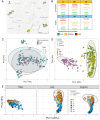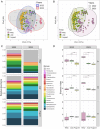Reproducing plant microbiome research reveals site and time as key drivers of apple tree phyllosphere bacterial communities
- PMID: 40664985
- PMCID: PMC12263852
- DOI: 10.1038/s41598-025-10729-0
Reproducing plant microbiome research reveals site and time as key drivers of apple tree phyllosphere bacterial communities
Abstract
Manipulating plant microbiomes is foreseen as a key biocontrol avenue to tackle the accelerating challenges of global change in agriculture. Several recent studies have identified the spatiotemporal dynamics of phyllosphere microbial communities, stressing the need to understand plant microbiome drivers to design efficient biocontrol interventions. Yet, these works are often performed on small sample counts, rarely provide sufficient information on the relative impact of time or local environment, and are seldom repeated to assess reproducibility. To address these limits, we performed a longitudinal sampling across multiple orchards of contrasting agricultural practices to study the ecological drivers of phyllosphere bacterial communities of apple tree (Malus domestica, Borkh.). We sampled up to eight apple cultivars at six orchards (three conventional, three organic) in the Eastern Townships (Canada) in 2022 and 2023. In contrast with common cross-sectional microbiome studies, our work builds on a two-year sampling design, thus allowing for the evaluation of the reproducibility of previous plant microbiome research. Our results support previous findings indicating that site and time are major drivers of apple tree bacterial community structure, yet their relative influence vary across the two sampling years. In addition, our data showed that leaf and flower bacterial alpha diversity is lower at organic sites compared to conventional sites. Overall, this study provides a comprehensive longitudinal multi-site study design highlighting the value of assessing reproducibility in plant microbiome studies and paving the way for future research in this field.
Keywords: Agricultural practices; Apple tree; Bacterial communities.; Longitudinal; Phyllosphere; Plant microbiome; Reproducibility; Spatiotemporal dynamics.
© 2025. The Author(s).
Conflict of interest statement
Declarations. Competing interests: The authors declare no competing interests.
Figures






Similar articles
-
The effects of small geographical resolution and age on the phyllosphere microbial diversity of Castanopsis eyrei in subtropical forest.Microbiol Spectr. 2025 Mar 4;13(3):e0209124. doi: 10.1128/spectrum.02091-24. Epub 2025 Feb 12. Microbiol Spectr. 2025. PMID: 39936891 Free PMC article.
-
Investigating the spatiotemporal dynamics of apple tree phyllosphere bacterial and fungal communities across cultivars in orchards.Can J Microbiol. 2024 Jun 1;70(6):238-251. doi: 10.1139/cjm-2023-0215. Epub 2024 Apr 19. Can J Microbiol. 2024. PMID: 38452350
-
A tale of two vineyards: parsing site-specific differences in bacterial and fungal communities of wine grapes from proximal vineyards and their changes during processing in a single winery.Appl Environ Microbiol. 2025 Jun 18;91(6):e0052625. doi: 10.1128/aem.00526-25. Epub 2025 May 5. Appl Environ Microbiol. 2025. PMID: 40323100 Free PMC article.
-
Systemic pharmacological treatments for chronic plaque psoriasis: a network meta-analysis.Cochrane Database Syst Rev. 2021 Apr 19;4(4):CD011535. doi: 10.1002/14651858.CD011535.pub4. Cochrane Database Syst Rev. 2021. Update in: Cochrane Database Syst Rev. 2022 May 23;5:CD011535. doi: 10.1002/14651858.CD011535.pub5. PMID: 33871055 Free PMC article. Updated.
-
Systemic pharmacological treatments for chronic plaque psoriasis: a network meta-analysis.Cochrane Database Syst Rev. 2017 Dec 22;12(12):CD011535. doi: 10.1002/14651858.CD011535.pub2. Cochrane Database Syst Rev. 2017. Update in: Cochrane Database Syst Rev. 2020 Jan 9;1:CD011535. doi: 10.1002/14651858.CD011535.pub3. PMID: 29271481 Free PMC article. Updated.
References
-
- Vorholt, J. A. Microbial life in the phyllosphere. Nat. Rev. Microbiol.10, 828–840 (2012). - PubMed
-
- Peixoto, R. S. et al. Harnessing the Microbiome to prevent global biodiversity loss. Nat. Microbiol.7, 1726–1735 (2022). - PubMed
-
- Banerjee, S. & van der Heijden, M. G. A. Soil microbiomes and one health. Nat. Rev. Microbiol.21, 6–20 (2023). - PubMed
MeSH terms
Substances
LinkOut - more resources
Full Text Sources

